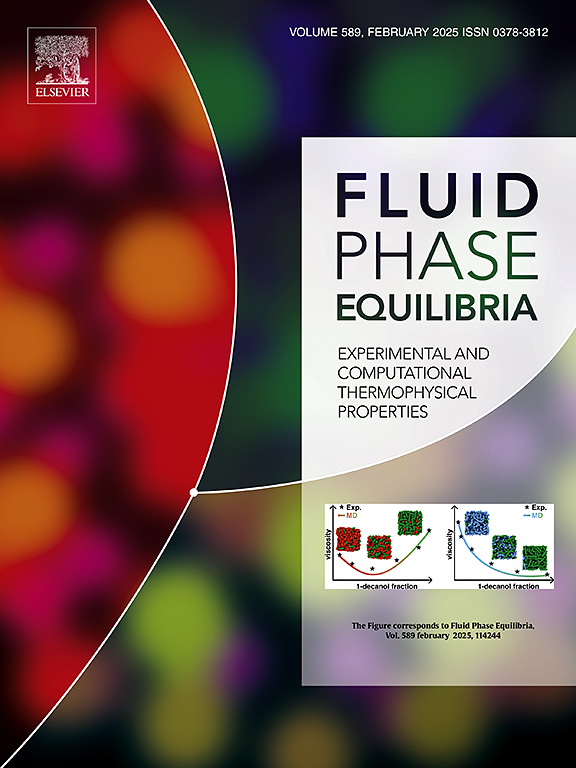The impact of inaccurate property data in process modelling
IF 2.8
3区 工程技术
Q3 CHEMISTRY, PHYSICAL
引用次数: 0
Abstract
It is widely accepted that high-quality thermophysical property data are essential for the accurate modelling of chemical processes, both in the conceptual design phase of process development and in the optimization of existing processes. Unfortunately, over the last decades, the chemical industry has experienced the closure of many physical property data laboratories. This trend is not limited to experimental facilities, also applied thermodynamic groups have been significantly downsized or sometimes extinguished. Process engineers and modelling experts often take over the tasks of evaluating and testing the thermodynamic property packages used in their models. From the simulation industry, we see that it is increasingly common that users request out-of-the-box property data that can be used directly in their simulations. Estimation methods are sometimes being used without a proper acknowledgment of their limitations and associated uncertainties. We believe it is, therefore, important to raise awareness of how large the impact of potential property data errors on process modelling can be, more specifically on the modelling of typical downstream unit operations. In this work, we provide practical insights on this issue, by revisiting textbook examples and by delving into real-life industrial cases we have encountered over the years. Critical considerations on the direct use of data from large databanks and estimation methods are also presented. The last is particularly relevant, with an increasing number of research groups working on the development of machine learning methods as means to generate massive amounts of property data.
不准确的属性数据对过程建模的影响
人们普遍认为,无论是在工艺开发的概念设计阶段还是在现有工艺的优化阶段,高质量的热物理性质数据对于化学过程的精确建模都是必不可少的。不幸的是,在过去的几十年里,化学工业经历了许多物理性质数据实验室的关闭。这种趋势不仅限于实验设备,应用的热力学组也已大大缩小或有时消失。过程工程师和建模专家经常接管评估和测试在他们的模型中使用的热力学属性包的任务。从模拟行业来看,我们看到用户请求可以直接在模拟中使用的开箱即用属性数据越来越普遍。有时使用估计方法时没有适当认识到它们的局限性和相关的不确定性。因此,我们认为,重要的是提高人们对潜在属性数据错误对流程建模的影响有多大的认识,更具体地说,是对典型下游单元操作建模的影响。在这项工作中,我们通过重温教科书中的例子和深入研究我们多年来遇到的现实工业案例,为这个问题提供了实际的见解。对直接使用来自大型数据库的数据和估计方法的关键考虑也被提出。随着越来越多的研究小组致力于开发机器学习方法,作为生成大量财产数据的手段,最后一点尤为重要。
本文章由计算机程序翻译,如有差异,请以英文原文为准。
求助全文
约1分钟内获得全文
求助全文
来源期刊

Fluid Phase Equilibria
工程技术-工程:化工
CiteScore
5.30
自引率
15.40%
发文量
223
审稿时长
53 days
期刊介绍:
Fluid Phase Equilibria publishes high-quality papers dealing with experimental, theoretical, and applied research related to equilibrium and transport properties of fluids, solids, and interfaces. Subjects of interest include physical/phase and chemical equilibria; equilibrium and nonequilibrium thermophysical properties; fundamental thermodynamic relations; and stability. The systems central to the journal include pure substances and mixtures of organic and inorganic materials, including polymers, biochemicals, and surfactants with sufficient characterization of composition and purity for the results to be reproduced. Alloys are of interest only when thermodynamic studies are included, purely material studies will not be considered. In all cases, authors are expected to provide physical or chemical interpretations of the results.
Experimental research can include measurements under all conditions of temperature, pressure, and composition, including critical and supercritical. Measurements are to be associated with systems and conditions of fundamental or applied interest, and may not be only a collection of routine data, such as physical property or solubility measurements at limited pressures and temperatures close to ambient, or surfactant studies focussed strictly on micellisation or micelle structure. Papers reporting common data must be accompanied by new physical insights and/or contemporary or new theory or techniques.
 求助内容:
求助内容: 应助结果提醒方式:
应助结果提醒方式:


